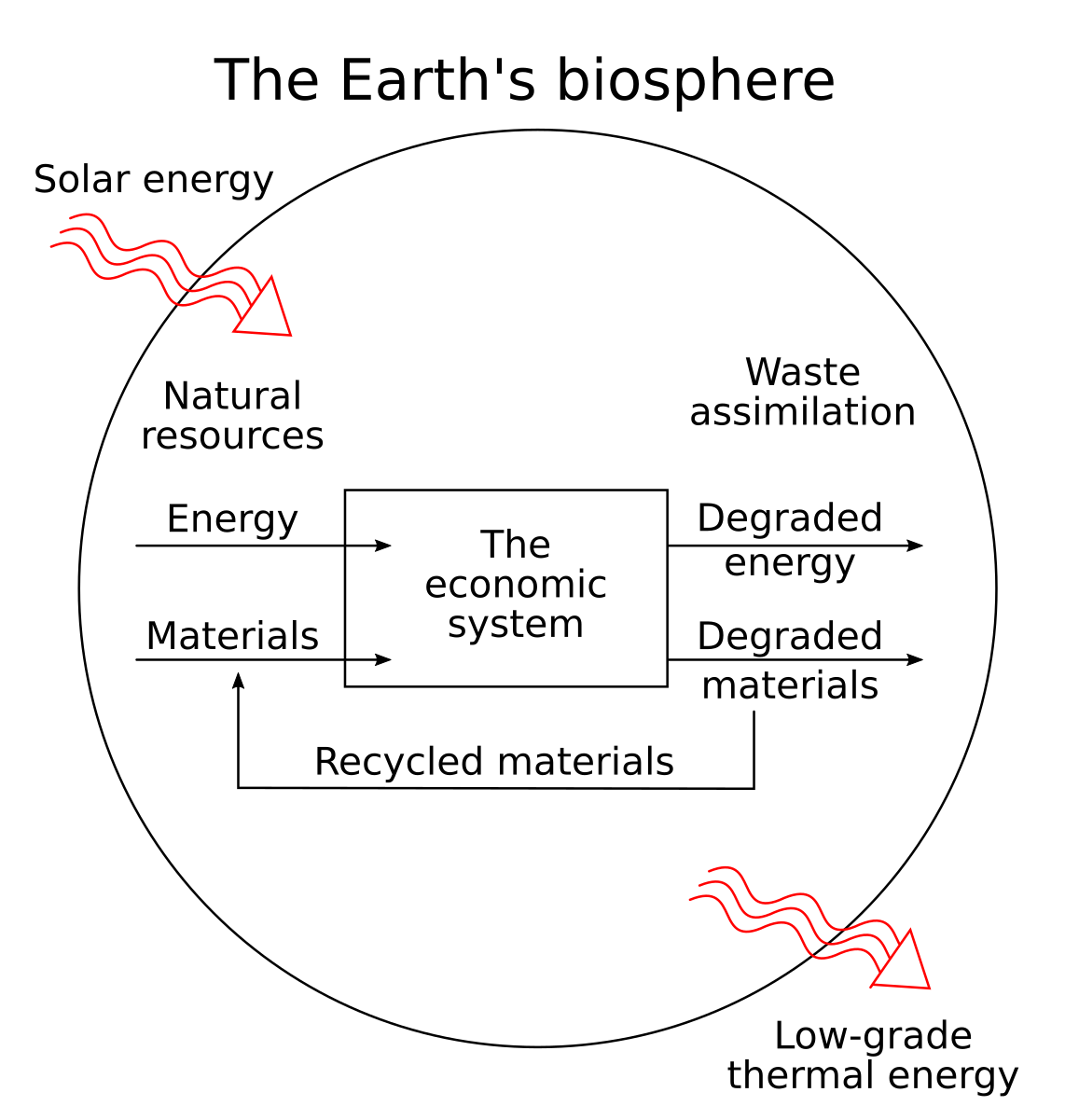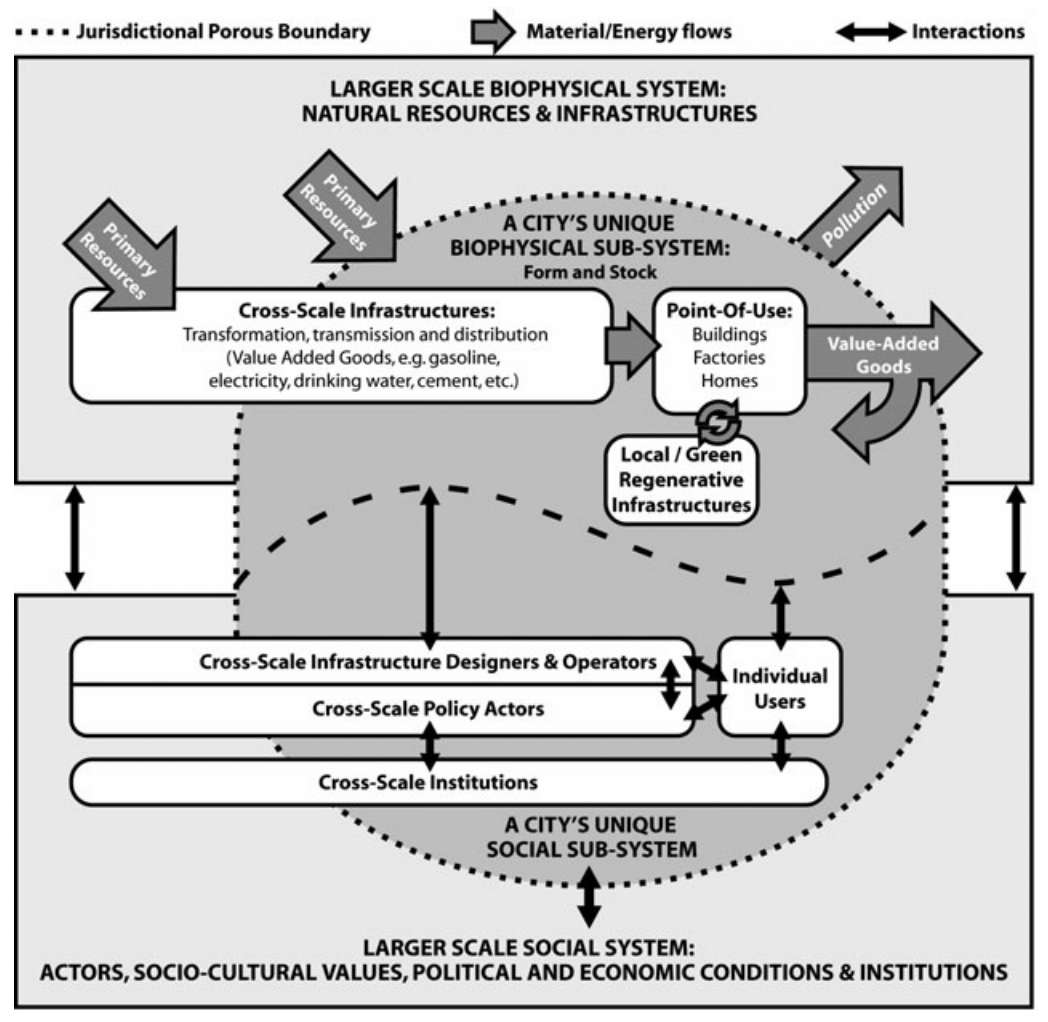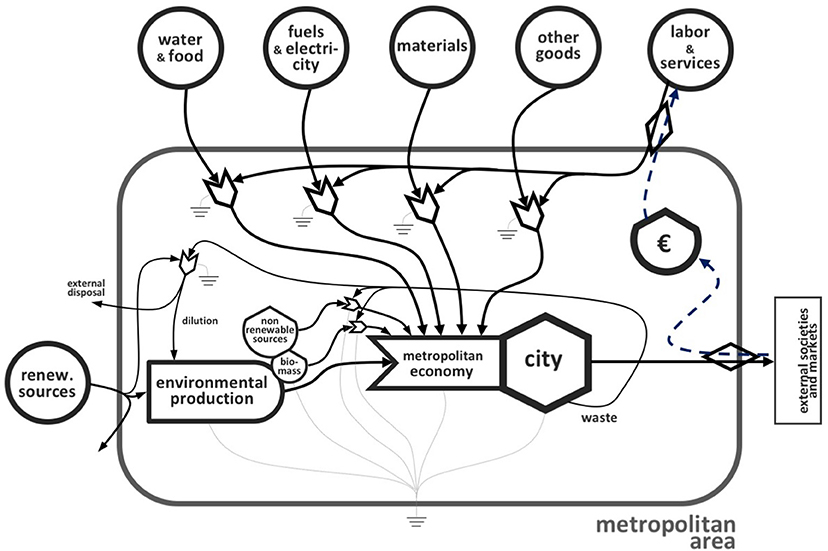IB Syllabus focus:
‘Urban ecosystems combine biotic and abiotic components with infrastructures and services. As systems, they involve flows of energy, materials, people, and information, raising issues of waste, efficiency, sustainability, and resilience.’
Urban ecosystems are complex, interconnected systems where biological, physical, and human-made components interact. Understanding these flows helps explain challenges of sustainability, waste, and resilience in modern cities.
The Concept of Urban Ecosystems
Urban ecosystems as systems
Cities function as systems because they include both biotic (living organisms such as humans, plants, and animals) and abiotic (non-living factors like air, water, soil, and infrastructure) components. These interact continuously, creating flows and feedback loops.
Urban Ecosystem: A system that combines living organisms, physical environment, and built infrastructure in urban spaces, with flows of energy, materials, people, and information.
Unlike natural ecosystems, urban systems rely heavily on external inputs of energy and resources, and they often generate large amounts of waste.

Diagram showing how valuable resources enter the human system, are transformed into goods and services, and exit as wastes and pollution; energy dissipation and limited material recycling are indicated. Use it to discuss why efficiency and waste prevention are core urban-system concerns. Source.
Flows in Urban Ecosystems
Flows of energy
Energy flows in urban areas mainly derive from fossil fuels, renewable sources, and electricity grids.
Urban energy consumption is concentrated in transport, heating/cooling, and industry.
Unlike in natural ecosystems, energy flows are largely linear—resources are consumed and waste heat is lost rather than being recycled efficiently.
Flows of materials
Cities import food, water, construction materials, and manufactured goods.
Outputs include solid waste, sewage, emissions, and industrial by-products.
The imbalance between inflows and outflows often creates issues of waste accumulation and pollution.
Flows of people
Movement includes commuting, migration, tourism, and daily mobility.
These flows influence the demand for housing, services, and infrastructure.
Rapid urban population growth increases pressure on transport networks, health services, and housing supply.
Flows of information
Urban areas act as hubs of communication and innovation.
Information flows through education, media, business networks, and technology.
Knowledge circulation contributes to urban resilience and adaptability.
Characteristics of Urban Ecosystems
Interconnectedness
Urban ecosystems cannot be understood in isolation. A change in one part—for example, increased car usage—affects air quality, human health, and transport efficiency.
Scale
Flows occur at different spatial scales:
Local (neighbourhood waste disposal)
Regional (commuter transport)
Global (energy imports, international trade)
Complexity
Urban systems involve multiple stakeholders—governments, businesses, residents, and NGOs—whose decisions influence flows and interactions.
Key Issues in Urban Ecosystems
Waste management
Urban areas generate massive volumes of solid waste and wastewater.
Inadequate management leads to land, water, and air pollution.
Strategies include recycling programmes, energy recovery from waste, and improved sewage treatment.
Efficiency
Resource efficiency measures how effectively energy and materials are used.
Inefficient systems waste resources, increase costs, and degrade the environment.
Sustainable cities aim for energy efficiency, reduced waste, and optimised transport.
Sustainability
A sustainable urban system balances environmental, social, and economic needs.
Key aspects:
Affordable housing
Renewable energy
Efficient public transport
Green spaces
Recycling and water conservation
Resilience
Resilience: The ability of an urban system to withstand shocks and stresses (such as natural disasters, economic crises, or climate change) and continue functioning effectively.
Cities with resilient infrastructures—such as decentralised energy networks or flood management systems—are better prepared for environmental and social challenges.

Conceptual diagram of a city showing biophysical infrastructures that carry energy and materials, coupled with social actors and institutions that shape those flows and their impacts. The figure visualises cross-scale inputs, transformations, losses, and limited regenerative loops, aligning with urban metabolism thinking. Source.
Urban Ecosystems vs Natural Ecosystems
Differences
Energy use: Natural ecosystems rely on renewable energy flows (mainly sunlight); urban systems depend heavily on non-renewable resources.
Recycling: Natural ecosystems recycle materials efficiently; urban systems often follow a linear model with significant waste.
Biodiversity: Natural ecosystems are rich in species diversity, while urban ecosystems have lower biodiversity but high human density.
Similarities
Both involve biotic and abiotic interactions.
Both depend on flows of energy and matter.
Both demonstrate feedback loops that stabilise or destabilise the system.
Case Examples of Urban Ecosystem Approaches
Urban ecology
Urban ecology studies how humans interact with natural processes in cities. For example, urban green spaces improve biodiversity, regulate temperature, and enhance air quality.
Circular urban planning
Some cities adopt circular economy principles, where resources are reused and recycled rather than discarded. This reduces dependency on external inputs.
Biophilic design
Designing buildings and spaces with natural features (such as green roofs and vertical gardens) supports both well-being and ecological functions.
Systems Thinking in Urban Ecosystems
Inputs and outputs
Population Balance = Inputs – Outputs
Inputs = Births + Immigration (people moving in)
Outputs = Deaths + Emigration (people moving out)
While this is often used in demographic studies, it applies conceptually to urban ecosystems, where inputs and outputs of resources shape population and sustainability trends.
Feedback loops
Positive feedback: Growth in population increases housing demand, leading to more construction, which can attract more people.
Negative feedback: High pollution levels may reduce population attractiveness, limiting growth.
Towards Sustainable and Resilient Urban Systems
Urban ecosystems must be managed as interconnected systems where every flow and feedback matters. Improving waste management, efficiency, sustainability, and resilience is essential to balance ecological health with human needs.

Systems diagram of a city represented as an open system with renewable and imported inputs, internal transformations and stocks, and exported products and wastes; money/information connections are indicated. Use it to identify leverage points (e.g., where losses occur or where circular interventions can close loops). Source.
FAQ
Urban ecosystems are characterised by high population density, greater dependence on external resource inputs, and complex infrastructure systems such as transport networks, energy grids, and waste treatment facilities.
They also act as hubs for information flows, innovation, and global connectivity in ways that smaller settlements generally do not.
Cities are considered open systems because they constantly exchange energy, materials, and information with their surroundings.
Inputs include food, water, fuel, and raw materials, while outputs consist of waste, emissions, and economic goods. This openness distinguishes them from closed systems, where cycling is more contained.
Urban resilience refers to the ability of a city to withstand shocks such as floods, heatwaves, or infrastructure failures.
Climate change increases the frequency and severity of these shocks. Cities that integrate green spaces, flood defences, renewable energy, and decentralised infrastructure are better able to cope with climate-related stresses.
Social institutions, such as governments, businesses, and NGOs, shape how urban systems operate.
They regulate flows of energy and materials through policies, manage waste systems, and coordinate emergency responses. Their decisions directly influence sustainability and the resilience of the city.
Information flows help coordinate efficient use of resources and improve decision-making.
Examples include:
Smart grids balancing energy supply and demand.
Public transport apps reducing congestion.
Data from sensors monitoring pollution or water use.
By circulating knowledge quickly, cities can respond more effectively to environmental challenges.
Practice Questions
Question 1 (2 marks)
Define the term urban ecosystem.
Mark Scheme:
1 mark for identifying that an urban ecosystem includes biotic (living) and abiotic (non-living) components.
1 mark for stating that it also involves built infrastructure/services and flows of energy, materials, people, and information.
Question 2 (5 marks)
Explain how flows of materials and energy in urban ecosystems differ from those in natural ecosystems.
Mark Scheme:
1 mark for recognising that natural ecosystems primarily use renewable energy (sunlight) while urban systems depend heavily on non-renewable energy sources.
1 mark for identifying that natural ecosystems have cyclical material flows (nutrient recycling), whereas urban systems often follow a linear model with waste outputs.
1 mark for stating that energy in urban systems is lost as heat and not efficiently reused.
1 mark for highlighting that urban ecosystems import large volumes of food, water, and materials, whereas natural ecosystems rely mostly on local cycles.
1 mark for mentioning an implication of these differences, such as waste accumulation, pollution, or sustainability challenges.

